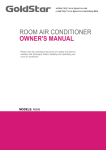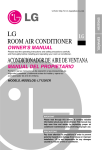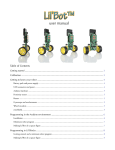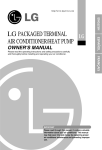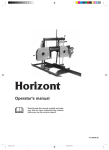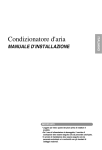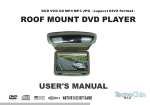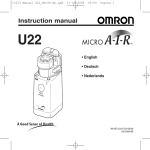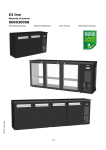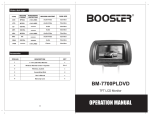Download Owner`s Manual - Appliance Factory Parts
Transcript
MODELS: L8004R, L1004R, CL8000ER IMPORTANT Please read through this manual. It contains valuable information about your air conditioner. This manual may help save time and money by explaining proper air conditioner maintenance and preventing improper use. PRECAUTIONS Pay close attention to precautions in order to prevent potential hazards and damage from misuse or improper installation. LG is not responsible for any damages caused by misuse of the air conditioner. ESPAÑOL OWNER'S MANUAL ENGLISH LG Window-Type Air Conditioner LG Window-Type Air Conditioner Owner’s Manual TABLE OF CONTENTS Safety Precautions..........................3 FOR YOUR RECORDS Write the model and serial numbers here: Before Operation .............................7 Model # Serial # Introduction ....................................8 Symbols Used in this Manual ........8 Features ........................................8 Electrical Safety ..............................9 Temporary Use of an Adapter ........................................10 Temporary Use of an Extension Cord ............................10 Installation ....................................11 Window Requirements ................11 Size ...........................................11 Clearance .................................12 Preparation of Chassis ...............13 Unit Installation ............................14 Operating Instructions .................16 Remote Control Operations ........16 Remote Controller .......................17 Additional Features.......................18 Air Direction ..............................18 Vent Control ..............................18 Drain Pipe..................................19 Removal from Window...............19 Maintenance and Service ............20 Air Filter ....................................20 Cleaning the Air Conditioner .....20 How to Remove the Front Grille ................................21 Common Problems and Solutions.......................................22 Troubleshooting ............................23 2 Room Air Conditioner You can find the numbers on a label on the side of the product. Dealer's Name Date Purchased ■ Staple your receipt to this page in the event you need it to prove date of purchase or for warranty issues. READ THIS MANUAL Inside you will find many helpful hints on how to use and maintain your air conditioner properly. Just a little preventive care on your part can save you a great deal of time and money over the life of your air conditioner. You'll find many answers to common problems in the chart of troubleshooting tips. If you review our chart of Troubleshooting Tips first, you may not need to call for service at all. PRECAUTION • Contact an Authorized Service Center for repair or maintenance of this unit. Call 1-800-243-0000 to locate the nearest ASC. • This air conditioner is not intended for use by young children or invalids without supervision. • Young children should be supervised to ensure that they do not play with the air conditioner. • If the power cord requires replacement, have an Authorized Servicer install an exact replacement part. • Installation work must be performed in accordance with the National Electric Code by qualified and authorized personnel only. Safety Precautions Safety Precautions WARNING This symbol indicates the possibility of death or serious injury. CAUTION This symbol indicates the possibility of injury or damage to property only. ■ Meanings of symbols used in this manual are as shown below. Be sure not to do. Be sure to follow the instruction. WARNING ■ Installation Always install the expansion panel(s). • Improper assembly or installation may cause incorrect operation, including injury, fire, and electric shock hazards. Do not use the power cord near flammable gas or combustibles such as gasoline, benzene, thinner, etc. • It may cause explosion or fire. Do not place the power cord near a heater. • It may cause fire and electric shock. Do not disassemble or modify products. • It may cause electric shock and failure. Gasolin Owner’s Manual 3 ENGLISH To prevent injury to the user or other people and property damage, the following instructions must be followed. ■ Incorrect operation due to ignoring instructions will cause harm or damage. The seriousness is classified by the following indications. ■ Because of the weight of the product, it is recommended that you have a helper to assist in the installation. Safety Precautions ■ Operation Plug in the power plug properly. • Otherwise, it will cause electric shock or fire. Do not operate or stop the unit by inserting or pulling out the power plug. Do not damage or use an unspecified power cord. • It will cause electric shock or fire. • It will cause electric shock or fire. ON ON Do not modify power cord length. • It will cause electric shock or fire. Unplug the unit if strange sounds, odors, or smoke come from it. • Otherwise it will cause fire and electric shock accident. 4 Room Air Conditioner Use the air conditioner on a single outlet circuit. (See page 7.) Do not share the outlet with other appliances. • It will cause electric shock or fire. Do not use the socket if it is loose or damaged. • It may cause fire and electric shock. Always plug into a grounded outlet. • No grounding may cause electric shock. Do not operate with wet hands or in damp environment. • It may cause electric shock. Safety Precautions Close all doors, windows and other outside openings to the room. • It may cause explosion, fire, and burn. If water enters the product, turn off the the power switch of the main body of appliance. Contact service center after taking the powerplug out from the socket. • It will cause electric shock or failure of machine. Do not clean the air conditioner with water. • Water may enter the unit and degrade the insulation. It may cause an electric shock. CAUTION ■ Installation Never touch the metal parts of the unit when removing the filter. • They are sharp and may cause injury. Do not block the inlet or outlet. • It may cause failure of appliance or performance deteriorate. Ensure that the outer case is not damaged by age or wear. • If the outer case is damaged, it must be repaired or replaced immediately. Leaving it damaged could result in the air conditioner falling out of the window, creating a safety hazard. Owner’s Manual 5 ENGLISH • The air conditioner must be operated in a enclosed area to be most effective. Ventilate before operating air conditioner when gas goes out. Safety Precautions ■ Operation Be cautious not to touch the sharp edges when installing. • It may cause injury. Sharp edges Unplug the air conditioner before cleaning it. Hold the plug by the head when taking it out. • It may cause electric shock and damage. Do not put a pet or house plant where it will be exposed to direct air flow. • Since the fan rotates at high • This could injury the pet or speed during operation, it may plant. cause injury. Always insert the filter securely. Clean it every two weeks. • Operation without filters will cause failure. Use a soft cloth to clean. Do not use wax, thinner, or a strong detergent. • The appearance of the air conditioner may deteriorate, change color, or develop surface flaws. x Wa Thinner 6 Room Air Conditioner Unplug the air conditioner if it will not be used for a long period. • It will waste power consumption in vain and it may cause accident. Do not use this appliance for special purposes such as pets, foods, precision machinery, or objects of art. • It is an air conditioner, not a precision refrigeration system. Do not drink water drained from air conditioner. Do not direct airflow at room occupants only. • It is not sanitary and could cause illness or personal injury hazard. Before Operation Before Operation 1. 2. 3. 4. 5. Plug in the power cord properly. Use a dedicated circuit. Overloading the line could create a fire hazard. Do not use an extension cord. See page 10 for more details. Do not start/stop operation by plugging/unplugging the power cord. If the power cord is damaged and requires replacement, have an Authorized Servicer install an exact replacement part. Usage 1. Being exposed to direct airflow for an extended period of time could be hazardous to your health. Do not expose occupants, pets, or plants to direct airflow for extended periods of time. 2. Due to the possibility of oxygen deficiency, ventilate the room when used together with stoves or other heating devices. 3. Do not use this air conditioner for non-specified special purposes (e.g. preserving precision devices, food, pets, plants, and art objects). Such usage could damage the items. 4. The air conditioner is a consumer comfort appliance, not a precision climate control system. Cleaning and Maintenance 1. Do not touch the metal parts of the unit when removing the filter. Injuries can occur when handling sharp metal edges. 2. Do not use water to clean inside the air conditioner. Exposure to water can destroy the insulation, leading to possible electric shock. 3. When cleaning the unit, first make sure that the power and breaker are turned off. The fan rotates at a very high speed during operation. There is a possibility of injury if the unit’s power is accidentally triggered on while cleaning inner parts of the unit. Service For repair and maintenance, contact an Authorized Service Center. See the warranty page for details or call (800) 243-0000. Have your model number and serial number available. They should be written on page 2 of this manual. Owner’s Manual 7 ENGLISH Preparing for Operation Introduction Introduction Symbols Used in this Manual This symbol alerts you to the risk of electric shock. This symbol alerts you to hazards that could cause harm to the air conditioner. Tip! This symbol indicates special notes. Features WARNING: This appliance should be installed in accordance with the National Electric Code. Upper Guide Horizontal Air Deflector (Horizontal Louver) Vertical Air Deflector (Vertical Louver) Cabinet Air Discharge Front Grille Air Filter Air Intake (Inlet Grille) Brace Evaporator Control Board Compressor Condenser Base Pan Remote Controller 8 Room Air Conditioner Power Cord Electrical Safety Electrical Safety The power cord of this appliance is equipped with a three-prong grounding plug. To minimize the risk of electric shock, use the plug with a standard three-slot grounding wall power outlet. If the power outlet does not include a grounding slot, have a qualified electrician replace the outlet before you use the room air conditioner. WARNING: Changing the outlet without making the appropriate wiring changes will create an unsafe condition that could result in fire or electrical shock. Refer all such work to a licensed and qualified electrician. Preferred method Ensure proper ground exists before use WARNING: Do not cut or remove the grounding prong from the power plug. WARNING: Attaching the adapter ground terminal to the wall receptacle cover screw does not ground the appliance unless the cover screw is metal and not insulated, and the wall receptacle is grounded through the house wiring. WARNING: If you have any doubt whether the air conditioner is properly grounded, have the wall receptacle and circuit checked by a qualified electrician. Owner’s Manual 9 ENGLISH WARNING: This appliance must be properly grounded. Electrical Safety Temporary Use of an Adapter We strongly discourage the use of an adapter due to potential safety hazards. For temporary connections, use only a UL-listed adapter, available from most local hardware stores. Ensure that the large slot in the adapter is aligned with the large slot in the receptacle for a proper polarity connection. To disconnect the power cord from the adapter, use one hand on each to avoid damaging the ground terminal. Avoid frequently unplugging the power cord as this can lead to eventual ground terminal damage. Temporary method Adapter Plug Metal Screw Receptacle Cover WARNING: Never use the appliance with a broken adapter. Temporary Use of an Extension Cord We strongly discourage the use of an extension cord due to potential safety hazards. For temporary situations, use only CSA certified and UL listed 3-wire grounded extension cords, rated 15 A, 125 V. 10 Room Air Conditioner Installation Installation Type C: 1 EA (Drain Joint Pipe) Type D: 3 EA (L Bracket) 16mm 10mm Type B: 5 EA (Wood Screw) Type E: 1 EA (Seal Strip) Type F: 1 EA (Sash Seal) (Adhesive backed) (Not adhesive backed) Type G: 2 EA (Guide Panel) Type H: 1 EA (Support Bracket) Have the following tools available for installation: * Screwdriver (Slotted and Phillips) * Knife * Pencil * Ruler * Hammer * Level Window Requirements Size This room air conditioner is designed for installation in standard double-hung windows with actual opening widths from 22" to 36". The upper and lower window sash must open sufficiently to allow a clear vertical opening of 13" from the bottom of the upper sash to the window stool. 22" to 36" 13" min WARNING: This product is a WINDOW AIR CONDITIONER. As such, a standard single-hung or double-hung window is required for proper installation. Non-window installations, including using sleeves, holes in walls, and other installations are not recommended. Owner’s Manual 11 ENGLISH Type A: 11 EA (Short Screw) Installation Clearance Proper clearance enhances the cooling efficiency of the unit and prevents heat radiation of the condenser. 1. If a storm window presents interference, fasten a 2" wide wood strip to the inner window sill across the full width of the sill. The wood strip should be thick enough to raise the height of the window sill so that the unit can be installed without interference by the storm window frame. 2. See Figure. B. The top of the wood strip should be approximately 3/4" higher than the storm window frame (Storm Window Frame) or wood strip (Outdoors) to help condensation to drain properly to the outside. 3. Install a second wood strip (approximately 6" long by 11/2" wide and same thickness as first strip) in the center of the sill flush against the back off the inner sill. This will raise the L bracket as shown Figure. B. 4. If the distance between Storm Window Frame and Wood Strip Mounted on Top of Inner Sill is more than 1", two of wood strips are not necessary. Wood Strip Mounted on Top of Inner Sill Inner Sill 1" Max. 3 /4" Clearance Storm Window Frame Inner Sill Wood Strip for L Bracket Outer Sill Outer Sill Indoors Outdoors Indoors Figure. A 12 Room Air Conditioner Outdoors Figure. B Installation Preparation of Chassis ENGLISH 1. Insert the guide panels into the guides of the air conditioner. Fasten the curtains to the unit with screws (Type A). Type A Tip! : Use a long screwdriver and installing the screws will be easier. Type A 2. Cut the adhesive-backed seal strip (Type E) to the window width. Remove the backing from the seal strip and attach the seal strip to the underside of the bottom window. 3. Locating unit in window Open the window and mark center line on the center of the inner sill. Seal Strip (Type E) Center Line Inner Sill Room Side 4. Attach L bracket 4-1. Install the L brackets behind the inner window sill, with short side of bracket as shown. Use the 2 screws (Type A) provided. 4-2. The bracket helps to hold unit securely in place. Be sure to place bracket edge flush against back of inner sill. Inner Sill Type A Outer Sill Inside Center Line 8" 8" Outside L Bracket Owner’s Manual 13 Installation Unit Installation Caution: During the following step, hold unit firmly until window sash is lowered to top channel behind side panel frames. Personal injury or property damage may result if unit falls from window. 1. Install the air conditioner in the window 1-1. Carefully lift the air conditioner and slide it into the open window. Make sure the bottom guide of the air conditioner drops into the notches of the L bracket. C ool F F an Dry Tip! : When the air conditioner drops into the L bracket, the air conditioner will be centered in window opening. 1-2. While steadying the air conditioner, carefully bring the window sash down behind the upper guide of the air conditioner. When the air conditioner is properly installed, it should tilt slightly down at the back. If it is set correctly in the window, it will hang lower in the back automatically. If it does not, there is a problem with the installation. F 1 L OW F 2 ME D F 3 HIG H E nergy S aver T imer T E MP C enter Line Window Frame Upper Guide Seal About 1/4" Bottom Guide L Bracket 2. Secure the guide panels Extend the guide panels (Type G) to fill the window opening using 4 screws (Type B) to secure them. 3. Install the sash seal and sash lock 3-1. Cut the sash seal (Type F) to the window width. Stuff the sash seal between the glass and the window to prevent air and insects from getting into the room. 3-2. Fasten the L bracket using a screw (Type A). 3-3. Remove the screws that secure the cabinet and base pan in the right side. 14 Room Air Conditioner L Bracket Type A Type B Sash Seal (Type F) Installation Type B Support Bracket (Type H) 4. Window installation of room air conditioner is now completed. See ELECTRICAL DATA for attaching power cord to electrical outlet. Owner’s Manual 15 ENGLISH 3-4. Fasten the support bracket (Type H) using a screw removed from the air conditioner cabinet. Attach the support bracket (Type H) to the inner window sill with a screw (Type B). Operating Instructions Remote Control Operations The controls look like this: Controls Cool F F1 LOW F2 MED F3 HIGH Energy Saver 6 Fan Dry Timer 4 3 5 TEMP 2 1 1 POWER Operation starts when this button is pressed and stops when you press the button again. 2 FAN SPEED SELECTOR For increased power while cooling, select a higher fan speed. 3 steps: High Low Med 3 ON/OFF TIMER The timer can be set to start and stop the unit in hourly increments (up to 12 hours). 4 OPERATION MODE SELECTOR Select cooling mode to cool the room. Select energy saver mode for energy saving operation. Select fan mode for basic ventilating fan operation. Select dry mode for dry operation. 5 TEMPERATURE CONTROL The thermostat monitors room temperature to maintain the desired temperature. The thermostat can be set between 60 F~86 F (16 C~30 C). The unit takes an average of 30 minutes to adjust the room temperature by 1 F. 6 REMOTE CONTROL SENSOR AUTO RESTART In failure of electric power, the unit runs as previous setting operation. 16 Room Air Conditioner Operating Instructions Remote Controller Power Operation starts when this button is pressed and stops when you press the button again. Temperature Control The thermostat monitors room temperature to maintain the desired temperature. The thermostat can be set between 60 F~86 F (16 C~30 C). The unit takes an average of 30 minutes to adjust the room temperature by 1 F. Power Temp Fan Speed Fan Speed For increased power while cooling, select a higher fan speed. 3 steps: High Low Med Timer Mode Auto Swing On/Off Timer The timer can be set to start and stop the unit in hourly increments (up to 12 hours). Operation Mode Selector Select cooling mode to cool the room. Select energy saver mode for energy saving operation. Select fan mode for basic ventilating fan operation. Select dry mode for dry operation. How to Insert Batteries 1. Remove the cover from the back of the remote controller 2. Insert two batteries. Be sure of the polarity when installing the batteries. Be sure that both batteries are new. 3. Re-attach the cover. Do not use rechargeable batteries. Such batteries differ from standard dry cells in shape, dimensions, and performance. Remove the batteries from the remote controller if the air conditioner is not going to be used for an extended length of time. Owner , s Manual 17 ENGLISH CAUTION: The Remote Controller will not function properly if strong light strikes the sensor window of the air conditioner or if there are obstacles between the Remote Controller and the air conditioner. Operating Instructions Additional Features Air Direction Airflow can be adjusted by changing the direction of the air conditioner's louvers. This can also increase the cooling efficiency of the air conditioner. Adjusting Horizontal Air Flow Direction Adjusting the vertical louvers left and right will change horizontal airflow. Adjusting Vertical Air Flow Direction Adjusting horizontal air flow Adjusting the horizontal vane up and down will change vertical airflow. The vane can be adjusted by nudging the back or up and down of the vane. Recommended orientation of louvers Adjust louvers to face upwards when cooling to maximize cooling efficiency. Adjusting vertical air flow Vent Control For maximum cooling efficiency, CLOSE the vent. This will allow internal air circulation. OPEN the vent to discharge stale air. CLOSE 18 Room Air Conditioner VENT OPEN Operating Instructions Additional Features ENGLISH Drain Pipe In humid weather, excess water may cause the Base Pan to overflow. To drain the water, remove the Drain Cap and secure the Drain Pipe to the rear hole of the Base Pan. Press the drain pipe into the hole by pushing down and away from the fins to avoid injury. This air conditioner is equipped with a slinger fan. (See drawing, below.) The fan has an outer ring that runs in the water that collects in the base pan if it gets deep. That condensate is then picked up by the fan and expelled through the condenser, making the air conditioner more efficient. Drain Pipe Drain Cap Ring CAUTION: Be careful when inserting the drain pipe. Push away from the sharp fin area to avoid slipping injuring yourself. Removal From Window Turn the air conditioner off, disconnect the power cord, remove the L bracket, the screws and Support Bracket installed through the top and bottom of the guide panels, and save for reinstallation later. Close the guide panels. Keeping a firm grip on the air conditioner, raise the sash, and carefully tilt the air conditioner backward, draining any condensate. Lift the air conditioner from the window and remove the sash seal from between the windows. Be sure to drain ALL condensate from the air conditioner. If you don't, it could run out while you carry the unit, making a mess and creating a slipping hazard. This simple step will save you much cleaning and make a safer work environment. Owner ,s Manual 19 Maintenance and Service Maintenance and Service Air Filter Check the air filter at least twice a month to see if cleaning is necessary. Trapped particles in the filter can build up and block the airflow, reducing cooling capacity and causing an accumulation of frost on the evaporator. To clean the air filter: Do not force open or open to far. 1. Pull the inlet grille forward. 2. Remove the air filter from the front grille by pulling the air filter up slightly. 3. Wash the filter using lukewarm water below 40 C (104 F). 4. Gently shake the excess water from the filter and replace. Cleaning The Air Conditioner The front grille and Inlet grille may be wiped with a cloth dampened in a mild detergent solution. The cabinet may be washed with mild soap or detergent and lukewarm water, then polished with Liquid Wax for Appliances. To ensure continued peak efficiency, the condenser coils (outside of unit) should be checked periodically and cleaned if clogged with soot or dirt from the atmosphere. 20 Room Air Conditioner Cool F1 LOW F2 MED F3 HIGH Energy Saver Fan Dry Timer TEMP F Maintenance and Service How to Remove the Front Grille 2. Remove the screw securing the Front Grille. 3. Push the grille up from the bottom and pull the top of the grille away from the case as the top tabs lift out of their slots. Cool F1 LOW F2 MED F3 HIGH Energy Saver F Fan Dry Timer TEMP Owner ,s Manual 21 ENGLISH 1. Pull the inlet grille forward Maintenance and Service Common Problems and Solutions Before Calling for Service If you have problems with your air conditioner, read the following information and try to solve the problem. If you cannot find a solution, turn off the air conditioner and contact your dealer. Air conditioner does not operate 1. Ensure that the air conditioner is plugged into a proper outlet. 2. Check the fuse or circuit breaker. 3. Check whether the voltage is unusually high or low. Air does not feel cold enough on the cooling setting 1. Ensure that the temperature settings are correct. 2. Check to see if the air filter is clogged with dust. If so, clean the filter. 3. Ensure that the air flow from the outside is not obstructed and that there is a clearance of over 20" between the back of the air conditioner and the wall or fence behind it. 4. Close all doors and windows and check for any source of heat in the room. Before calling for service, please review the following list of common problems and solutions. The air conditioner is operating normally when: • You hear a pinging noise. This is caused by water being picked up by the fan on rainy days or in highly humid conditions. This feature is designed to help remove moisture in the air and improve cooling efficiency. See the section on Slinger Fan, page 19. • You hear the thermostat click. This is caused by the compressor cycle starting and stopping. • You see water dripping from the rear of the unit. Water may be collected in the base pan in highly humid conditions or on rainy days. This water overflows and drips from the rear of the unit. • You hear the fan running while the compressor is silent. This is a normal operational feature. 22 Room Air Conditioner Maintenance and Service Troubleshooting Problem Air conditioner does not start Air conditioner does not cool as it should Possible Causes What To Do ■ The air conditioner is unplugged. • Make sure the air conditioner plug is pushed completely into the outlet. ■ The fuse is blown/circuit breaker is tripped. • Check the house fuse/circuit breaker box and replace the fuse or reset the breaker. ■ Power failure. • If power failure occurs, turn the mode control to Off. When power is restored, wait 3 minutes to restart the air conditioner to prevent tripping of the compressor overload. ■ Airflow is restricted. • Make sure there are no curtains, blinds, or furniture blocking the front of the air conditioner. ■ The thermostat may not be set high enough. • Turn the knob to a higher number. The highest setting provides maximum cooling. ■ The air filter is dirty. • Clean the filter at least every 2 weeks. See the care and Maintenance section. ■ The room may have been hot. • When the air conditioner is first turned on, you need to allow time for the room to cool down. ■ Cold air is escaping. • Check for open furnace floor registers and cold air returns. ■ Cooling coils have iced up. • See Air Conditioner Freezing Up below. Air conditioner freezing up ■ Ice blocks the air flow and stops the air conditioner from cooling the room. • Set the mode control at High Fan or High Cool with thermostat at 1 or 2. * You can refer to the Energy Star program in detail at www.energystar.gov. Owner’s Manual 23 ENGLISH The air conditioner may be operating abnormally when:
























